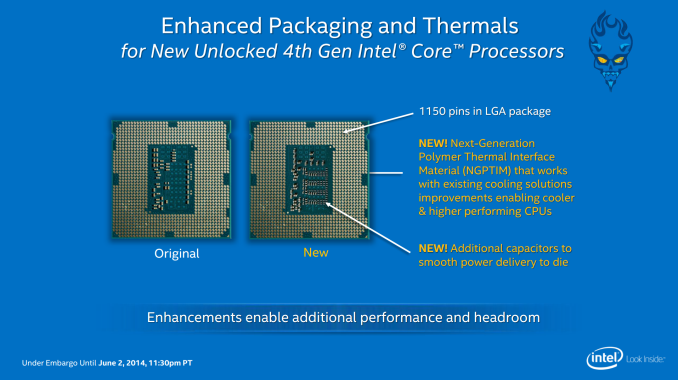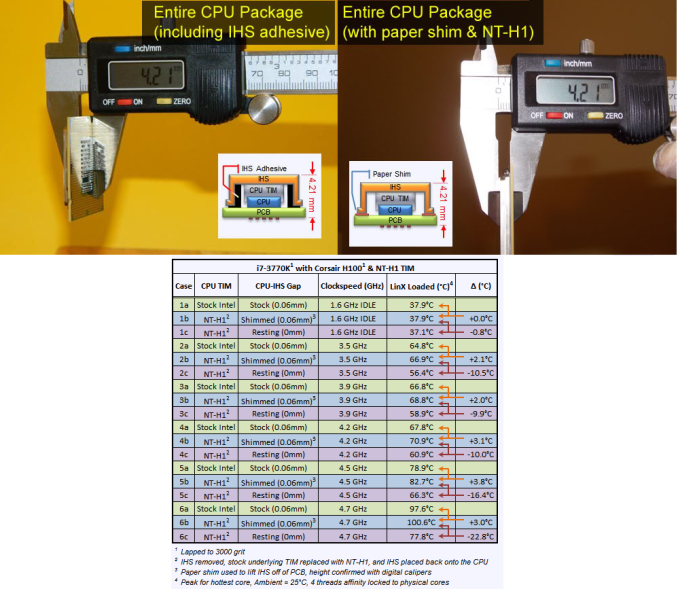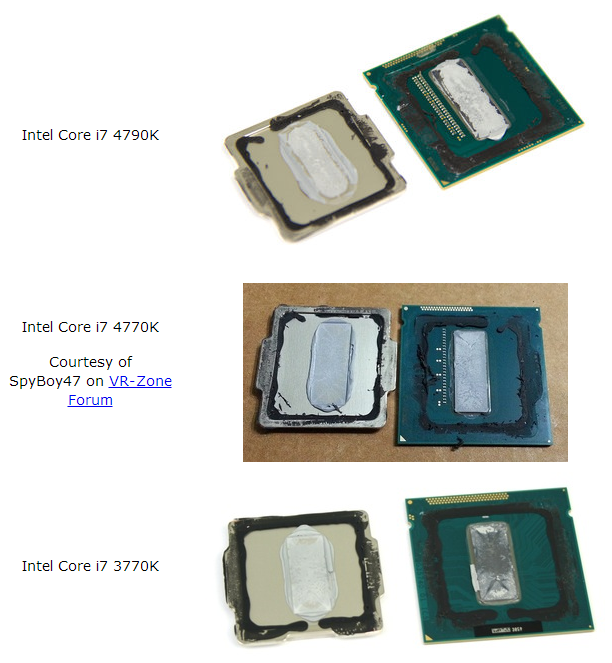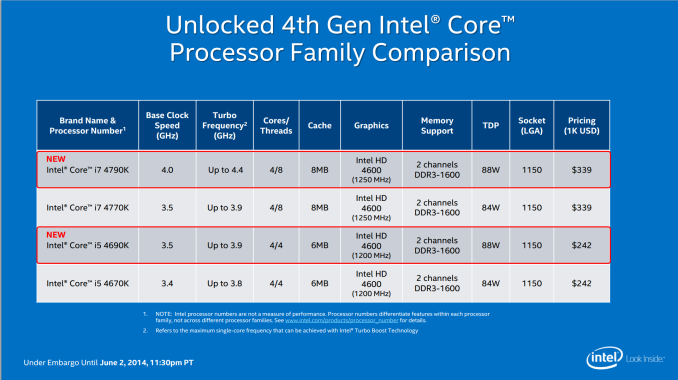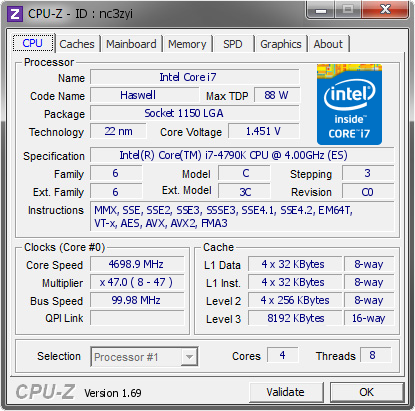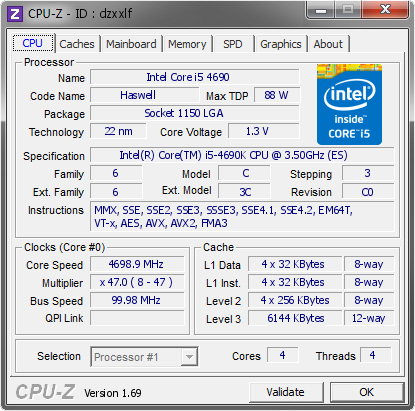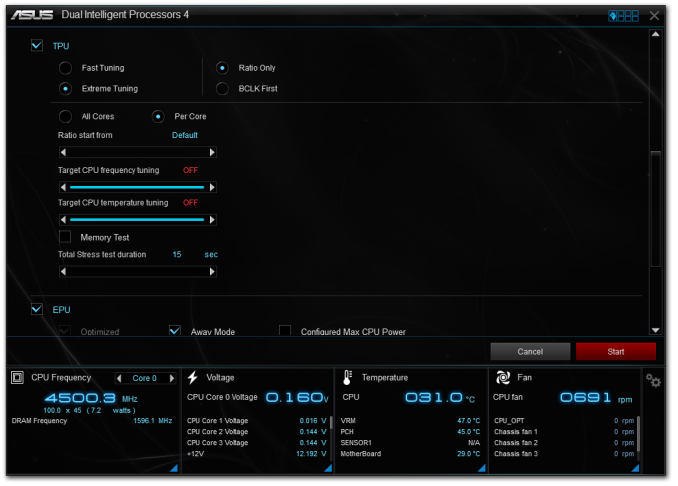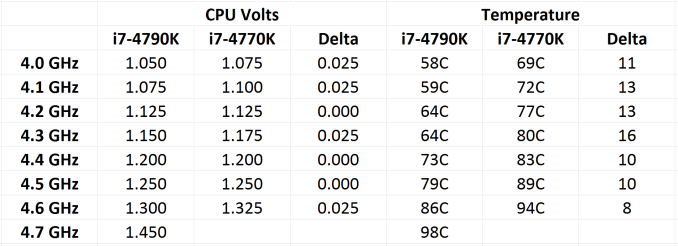
Original Link: https://www.anandtech.com/show/8227/devils-canyon-review-intel-core-i7-4790k-and-i5-4690k
Devil’s Canyon Review: Intel Core i7-4790K and i5-4690K
by Ian Cutress on July 11, 2014 10:00 AM EST- Posted in
- CPUs
- Intel
- Haswell
- i7
- Overclocking
- Devil's Canyon
- i5
- 4790K
- 4690K
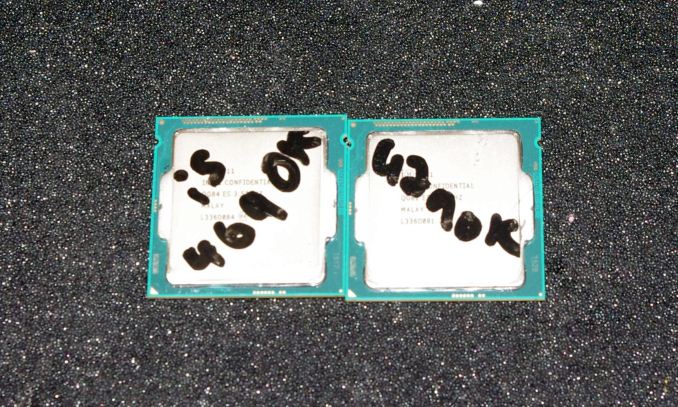
In the latter part of the last decade, getting performance on the cheap meant buying a low end processor and learning how to overclock it. This is how I started in building computers, but a few generations ago Intel locked it all down except for a few high-end models in each generation. Since then, due to various changes in packaging, each of the last few generations has anecdotally felt to offer less overclocking headroom or fewer highly overclocking parts, much to the chagrin of enthusiasts. With Devil’s Canyon, Intel aimed to address some of these concerns.
The Old and The New
The two Devil’s Canyon CPUs are part of a three-way release for Intel, with the announcement earlier in June and a full retail release by the end of the June (depending on location). The three CPUs are the dual core Pentium Anniversary Edition G3258, which we have tested and will write up in its own review, and the new Core series models, the quad-core i5-4690K and the quad core with hyperthreading i7-4790K. There are several reasons why the Pentium is not part of the 'Devil’s Canyon' line up, which we will go into in that review, but the Core models are upgrades of the i5-4670K and i7-4770K respectively.
In May we had the release of the Haswell Refresh CPUs, updated silicon featuring small clock boosts at all the major points. We posted a review of the i3-4360, i5-4690 and i7-4790 at the time which you can read here. The new Devil’s Canyon i7 and i5 CPUs are more than just jumps in clock speed like their Haswell Refresh brethren. Intel is keen to quote this slide referring to the ‘new features’ of these CPUs:
The two new official features are:
- New Thermal Interface Material, made with a Next Generation Polymer (NGPTIM)
- Additional capacitors on the underside for smoother power delivery
I will address the latter point first. According to my sources, these are extra decoupling capacitors in order to help smooth the delivery of voltages from the FIVR (fully integrated voltage regulator) to the various parts of the CPU. When at the high end of overclocking, reaching the limits of stability (limited by voltage for a given frequency), this should help maintain a constant voltage especially when load-line calibration settings are fixed. This should have ramifications for home users wanting to overclock significantly (4.7 GHz+) and are on ambient cooling methods, but it would seem that Intel’s main focus would be to assist sub-zero overclockers competing for records.
i7-3770K, i7-4770K, i7-4790K (left-to-right)
So why is helping the extreme, sub-zero overclockers a priority for Intel? The extreme overclocking community numbers a few thousand worldwide at most, but their exploits are often used in marketing material with Intel’s partners, such as ASUS, GIGABYTE, ASRock and MSI. One of the main criticisms for the Haswell line of overclocking CPUs was the inconsistency for these CPUs to hit high frequencies on a regular basis, with many enthusiasts testing several dozen (or even 100s) in order to find a good CPU for benchmarking competitions. This upgrade should be a nod towards that community, at least on paper.
The New Thermal Interface Material
Going back to talking about 24/7 overclocking, and the original launch Haswell CPUs have been varied in their performance. Anecdotally, I have had three i7-4770K CPUs to test, and with my concept of benchmarking stability (5 minutes OCCT and a POV-Ray test, max temperature 98C), one reached 4.7 GHz at 1.35 volts, one reached 4.6 GHz at 1.40 volts and another struggled to get 4.3 GHz at 1.40 volts. Initial reports showed that these CPUs ran hotter than even the previous generations, Sandy Bridge and Ivy Bridge, at a given frequency. This limited their overclocking potential on air and water. The move from Ivy Bridge to Haswell was an architecture change, with the focus on power savings and performance benefits taking advantage of the 22nm node rather than all-out performance at the expense of efficiency. There were many comments from users who were not expecting the new CPUs to be so varied, or that the peak temperature was reached so quickly. After all, the overclocking CPUs are expected be the highest quality silicon from the production line, the feeling that they varied so much was not a welcome characteristic. At the time, the suggestions were clear: for users running a good Sandy Bridge or Ivy Bridge CPU on a nice (4.6 GHz+) overclock, despite the IPC and power improvements for Haswell, the only reason to change might be for the chipset improvements.
As a result of these temperature issues, there was a lot of user research done into the reasons behind the increase. Most users complained on the issue of the thermal interface material being cheap, rather than soldered on which happened in older generations. Successful delidding (removal of the heatspreader) of CPUs and replacing the TIM led to various reports of a 10-20ºC drop in temperatures at a given voltage/frequency combination, and this has even led to MSI providing a shim with some of their Z97 overclocking motherboards so users who do delid can still provide an offset between the PCB and the die for air/water cooling. AnandTech Forum admin Idontcare posted an in-depth report regarding the dimensions of the CPUs, and his experiences with this type of packaging. His conclusion was that, for his Ivy Bridge CPU at least, the height of the heatspreader above the die was actually the cause for concern, with the heatspreader adhesive actually raising the heatspreader too far off the die, meaning that the gap was larger than expected and the TIM could not work properly. In fact, his conclusion is that the TIM is perfectly fine, but this gap is causing the issue.
For Devil’s Canyon, Intel is addressing the first issue, the quality of the thermal interface material. Their phrasing is to use a ‘Next Generation Polymer’ type of TIM, which is nice and ambiguous for any material scientists out there. The fact that it says polymer is a big clue that we are dealing with a silicone based TIM. ‘Next-Generation’ could easily mean version 2.0, so is almost non-descript and purely a marketing term. However, in order to increase the thermal efficiency of the TIM, I would hazard a guess that the TIM is more dense, and thus the polymer chains would either be longer or heaver (by using modified starting chemicals/catalysts), or the suspension matrix is different. These silicone based TIMs often hold a suspension of ceramic powders, which can also affect the thermal conductivity by a factor of 200x. ‘Next-Generation’ could imply that the ceramic has changed (this would also change the viscosity, perhaps severely so) to one with a higher thermal conductivity. The movement from a zinc-oxide filler to an aluminium based filler would offer a 2x improvement in thermal conductivity for the minor added expense, as well as cause a color change combined with a viscosity change.
With kudos to Matt Bach at Puget Systems, we can see images of the new CPUs delidded:
Comparing the i7-4790K to the i7-4770K, aside from the increase in internal capacitors (again, for power regulation), the TIM has changed more from a silver material to a whiter material, similar to that of the 3770K. The cynic in me would suggest a movement to a zinc-based ceramic filler, given that zinc is a d10 metal (10 electrons in its outer shell) and forms an extremely white powder when in the zinc oxide form, so much so that it is added to paints as a white pigment (similarly to titanium dioxide). However aluminium oxide is also white, and has a much higher thermal conductivity than zinc oxide when used in a thermal interface material matrix (quoted as 30 W m-1 K-1). The viscosity would be dependent on the size of the nanoparticles used against the matrix itself, but one could argue that the aluminum based TIM should be slightly more expensive than the zinc based TIM. It is worth noting that the black IHS adhesive is still present, in what looks like similar quantities. So should the black adhesive be the mitigating factor, users who have delidded and adjusted their previous CPUs might not see much of a difference (or a regression) by switching to an out-of-the-box Devil’s Canyon if the temperature issues are well and truly fixed.
Specifications
The big news in the specifications is that the i7-4790K is clocked much higher than was previously expected. The i7-4770K, its predecessor, was rated at a 3.5 GHz base frequency and offered a turbo speed for single core workloads of 3.9 GHz. The new i7-4790K will come with a 4.0 GHz base frequency (Intel likes to point out this is their first commercial quad-core CPU with a 4.0 GHz base clock) which offers a 4.4 GHz Turbo Mode. An extra 14% frequency for a similar price is not to be sniffed at although Intel does quote the TDP rising from 84W to 88W.
The i5-4690K is more like the Haswell refresh samples, marking a small +100 MHz increase in frequency over the i5-4670K. Here we move from a 3.4 GHz base / 3.8 GHz turbo to a 3.5 GHz base / 3.9 GHz turbo increase, and again an increase in TDP from 84W to 88W.
Both new models are also listed as supporting TSX-NI and VT-d.
| Intel Core i5 and i7 | ||||||
| i5-3570K | i5-4670K | i5-4690K | i7-3770K | i7-4770K | i7-4790K | |
| Core Name | Ivy Bridge | Haswell | Devil's Canyon | Ivy Bridge | Haswell | Devil's Canyon |
| Release | April 2012 | June 2013 | June 2014 | April 2012 | June 2013 | June 2014 |
| Socket | 1155 | 1150 | 1150 | 1155 | 1150 | 1150 |
| CPU Frequency | 3400 | 3500 | 3500 | 4000 | ||
| CPU Turbo | 3800 | 3900 | 3900 | 4400 | ||
| L3 Cache | 6 MB | 8 MB | ||||
| TDP | 77 W | 84 W | 88 W | 77 W | 84 W | 88 W |
| Threads | 4 | 8 | ||||
| AVX 2.0 | No | Yes | No | Yes | ||
| FMA3 | No | Yes | No | Yes | ||
| TSX-NI | No | Yes | No | Yes | ||
| VT-d | No | Yes | No | Yes | ||
| IGP | HD 4000 | HD 4600 | HD 4000 | HD 4600 | ||
| IGP Frequency | 650 | 350 | 650 | 350 | ||
| IGP Turbo | 1150 | 1200 | 1150 | 1250 | ||
| Memory | DDR3-1600 | |||||
| Price | $230 | $235 | $240 | $330 | $335 | $340 |
The CPUs still use the LGA1150 socket, meaning compatibility with 9-series motherboards and most 8-series motherboards (when the motherboard manufacturers release relevant updates for 8-series). We suggest that if you intend to purchase an 8-series motherboard with one of these CPUs that you contact your retailer ahead of time to confirm BIOS versions.
The increase in frequency for the top end i7 puts more distance in terms of CPU performance between that and the i5, which judging by the price difference might be significant, especially for prosumers that are CPU-bound. Things are less clear in the gaming arena, although we have tested both CPUs as well as with overclocks to see how they pan out.
Expectations on Overclocking
There was a lot of talk regarding the magic ‘5.0 GHz’ number and whether it would be easily achievable with these new processors. At Intel’s overclocking event at Computex this year, the highest frequency achieved with an all-in-one closed-loop-liquid-cooler was 5.5 GHz, although this was only stable enough for a CPU-Z screenshot and the air passing over the radiator was cooled with liquid nitrogen, so not a realistic scenario. Other reviews on these processors have had a hard time hitting 5.0 GHz stable, with most falling short by a couple of hundred MHz.
In order to even discuss this, we first have to look at the silicon itself. All arrows point to an unchanged silicon die, but an updated package, which would suggest that the overclocking performance of these new processors might match the old, but with more thermal headroom. Although one could also suggest that Intel has optimized the process in the fab to enable a different distribution of bin yields, especially when considering the new 4.0 GHz bin is considerably higher than the others. This would arguably put some positive note on the i7, given that there were some rather poor overclocking i7-4770Ks in the wild and the i7-4790K seems to raise that minimum barrier by default.
Without having a couple of hundred CPUs to test, we cannot produce a histogram of expected overclocking results. However I can add in our results here, with a clearer explanation later in the review.
Our i7-4790K is actually one of the lower performing CPUs from what I have heard from other reviewers. Using a Corsair H80i (the 120mm double thickness CLC), our CPU hit 4.6 GHz at 1.300 volts, with 86ºC peak temperature under OCCT load, and 4.7 GHz at 1.450 volts with 98ºC peak temperature under OCCT load.
1.450 volts for 4.7 GHz is rather a lot, and under a focused AVX load the system did actually reduce the frequency to 4.5 GHz for split-seconds to remain within thermal tolerances. That jump from 4.6 GHz to 4.7 GHz of 0.150 volts is quite a leap, although we did see this with the normal Haswell CPUs as well.
The i5-4670K sample we received by contrast was a relatively nice clocker, but it still had a bit of a voltage leap in the same sort of range. 4.7 GHz was achieved at a nice low 1.300 volts, with 79ºC peak temperature, however 4.8 GHz was a bit of a struggle. The system would boot very easily above 1.300 volts, but even at 1.450 volts, the system was not stable for our testing.
To add a few more data points into the mix:
Our G3258 (Overclockable Pentium) also does 4.7 GHz, at 1.375V stable.
A contact at Corsair has two i7-4790Ks, both of which do 4.7 GHz at 1.30-1.35 volts stable.
Two of our contacts at ASUS have got 4.8 GHz on their i7-4790Ks at 1.38 volts, but 4.9 is a no-go.
It would seem 4.7 GHz is the magical number, at least for an open test-bed in the summer for the north hemisphere. For the users that rely on one-button overclocking, or automatic overclocking (selecting High-OC), motherboard manufacturers will have to ensure that their look-up tables encoded into the BIOS are updated appropriately.
Performance and the Future
For the jump from Ivy Bridge to Haswell last year, our tests showed a 5-10% increase at the same clock speed. Because this year is just a Haswell to Haswell Redux, there is no IPC gain and thus it all comes down to clock speed. In this circumstance, the i7-4790K becomes an interesting prospect. Moving from 3.5 GHz base clock on the i7-4770K to 4.0 GHz base frequency is a >14% increase in performance at the similar price point. The turbo frequencies also gain that jump as well, from 3.9 GHz turbo to 4.4 GHz turbo, a +10% jump also. In essence what we have here is a performance jump to what we see in the tick-tock scale, albeit at the expense of power.
Although the power increase is a negative, the TDP numbers would suggest that the power efficiency increases, with a 14% increase in clock speed for only a 4W jump. Our next few pages of benchmarks will confirm if this is the case or not, although it means that the i7-4790K is not just for the ‘performance at any cost’ type of customer.
This 14% jump in clock speed (and any percentage increase in actual performance) is important when we consider Intel’s roadmap. Sandy Bridge was released in January 2011, Ivy Bridge in April 2012, then Haswell in June 2013. By that cadence, we should be expecting Broadwell, the change from 22nm to 14nm, in the October 2014 timeframe. Stories of Intel’s 14nm issues have been given attention in the media, although very few details have come from Intel itself. At Computex 2014, Intel made a mobile Core-M announcement (14nm Broadwell-Y, <10W models) for the holiday season at the end of the year. There is no exact date for the official release, and for the announcement no desktop parts were mentioned and thus it is still unclear when the full desktop parts will be available to end-users. In 2013 it was debated if Intel would be bringing Broadwell to a socketed desktop platform, although that was quashed when in May Intel announced it would be releasing an overclocking SKU with the next version of Iris Pro for Broadwell, suggesting that a full range of desktop parts with IGPs would be coming to market. Different sources will claim different times for the release, either alongside Core-M or later in 2015.
One could debate the impact if Intel had not released a part with 5-10% performance increase in 2014, and we can only speculate if Broadwell will offer a true IPC advantage. The question then becomes if Intel will release the equivalent of an i7-4790K with Broadwell, integrating any IPC increase with a frequency to succeed the i7-4790K. Given the lead in single threaded performance over AMD in the past couple of years in various workloads, one could also argue that Intel has had time to work on such a jump in order to placate their users and shareholders in the mainstream/performance segment. There has also been a suggestion that Broadwell-DT will only focus on the integrated graphics, and leave performance for either the extreme platform (Haswell-E) or the generation after, Skylake. The release of Skylake is even more a mystery. But there are different avenues for Intel to take when it comes to a 10% year-on-year increase in performance – either via frequencies or 10% IPC with their tick-tock.
The Brief Performance Rundown
I want to inject a little of the conclusion here, beyond the overclock results above. Out of the i5 and i7 models branded under the Devil’s Canyon name, the i7 is the most exciting. The increase in single core frequency was noticeable during our testing, even for basic tasks, and moreso than the movement from Ivy Bridge to Haswell in the first place.
I have taken a section of pure CPU benchmark results and done a comparison between the i7-3770K, i7-4770K and i7-4790K:
| Intel i7 Comparison | ||||
| Benchmark |
i7-4770K vs i7-3770K |
i7-4790K vs i7-4770K |
i7-4790K vs i7-3770K |
i7-4790K OC vs i7-3770K |
| 3DPM-ST | 2% | 13% | 15% | 23% |
| 3DPM-MT | 4% | 10% | 15% | 24% |
| WinRAR 5.01 | 2% | 6% | 8% | 11% |
| FastStone 4.9 | 7% | 13% | 19% | 23% |
| Xilisoft VC 7.5 LQ Film | 8% | 11% | 18% | 21% |
| Xilisoft VC 7.5 4K60p | 6% | 12% | 18% | 24% |
| PovRay 3.7 beta | 11% | 12% | 28% | 37% |
| HandBrake v0.9.9 LQ Film | 13% | 12% | 27% | 38% |
| HandBrake v0.9.9 4K60p | 12% | 7% | 20% | 24% |
| Agisoft PS v1.0 Stage 1 | 5% | 8% | 12% | 16% |
| Agisoft PS v1.0 Stage 2 | 3% | 1% | 3% | 7% |
| Agisoft PS v1.0 Stage 3 | 5% | 9% | 13% | 15% |
| Agisoft PS v1.0 Stage 4 | 7% | 11% | 17% | 24% |
| Agisoft PS v1.0 Mapping | 4% | 2% | 7% | 8% |
| TrueCrypt 0.7.1a | 18% | 13% | 33% | 41% |
| 7-Zip MIPS | 2% | 9% | 11% | 18% |
| Average | 7% | 9% | 17% | 22% |
Aside from the Dolphin Benchmark which has gains related to Haswell, the rest of the benchmark set shows an average increase from Ivy Bridge to Haswell of 7%. Those same tests, moving from i7 Haswell to the i7 Devil’s Canyon, give a 9% average benchmark increase. Most of those increases come from benchmarks that can take advantage of extra frequency due to parallelism, rather than cache limited scenarios for IPC. In particular, the video encoding benchmarks enjoy the extra frequency, but even a basic workload such as picture conversion saw an overall 19% increase from Ivy Bridge to Devil’s Canyon. Extra frequency is nothing to be sniffed at, if you do not mind that extra increase in power consumption. The main noticeable point however is that the system (anecdotally) felt faster, and the take home message is, at stock, if you need extra CPU performance and are running an i7-3770K or lower, there is a 17% boost to be had on the shelf right now, just over two years from Ivy Bridge launch. The recent yearly recommendations for the three-year upgrade cycle, for CPU limited scenarios, still holds true.
We also ran some numbers with the CPU overclocked to 4.7 GHz on all cores, which I will use for comparison later in the review.
On the gaming side of the equation, the results are not so clear cut. The i7-4790K offers a small upshift in IGP performance over the i7-4770K, but the HD4600 processors still have a nice gap away from the i7-3770K. For discrete GPU tests, we looked at single and dual GPU performance over six different types of games using different engines at 1080p with maximum settings. The only differences observed were for dual GPU environments:
| Intel i7 Gaming Average Frame Rates: GTX 770 at 1080p | ||||
| Benchmark | i7-3770K | i5-4690K | i7-4770K | i7-4790K |
| F1 2013 | 129.5 | 130.4 | 130.4 | 132.1 |
| Bioshock Infinite | 94.2 | 94.8 | 94.8 | 95.2 |
| Tomb Raider | 49.6 | 49.4 | 49.8 | 49.9 |
| Sleeping Dogs | 56.8 | 57.0 | 57.3 | 57.0 |
| Company of Heroes 2 | 43.6 | 44.0 | 42.8 | 43.4 |
| Battlefield 4 | 61.0 | 61.2 | 61.4 | 61.4 |
| Intel i7 Gaming Minimum Frame Rates: GTX 770 at 1080p | ||||
| F1 2013 | 105.8 | 102.4 | 99.1 | 108.2 |
| Bioshock Infinite | 24.1 | 29.9 | 26.7 | 28.6 |
| Tomb Raider | 36.0 | 35.8 | 34.8 | 36.9 |
| Sleeping Dogs | 34.6 | 34.8 | 34.2 | 34.9 |
| Company of Heroes 2 | 25.4 | 25.0 | 24.9 | 24.7 |
| Battlefield 4 | 50.1 | 49.9 | 50.1 | 50.0 |
| Intel i7 Gaming Average Frame Rates: 2x GTX 770 at 1080p | ||||
| F1 2013 | 123.4 | 125.8 | 128.5 | 127.0 |
| Bioshock Infinite | 155.7 | 159.8 | 160.8 | 164.1 |
| Tomb Raider | 96.4 | 96.6 | 97.6 | 97.2 |
| Sleeping Dogs | 101.4 | 105.9 | 104.4 | 105.9 |
| Company of Heroes 2 | 43.3 | 43.4 | 43.4 | 43.7 |
| Battlefield 4 | 105.3 | 108.2 | 106.5 | 107.5 |
| Intel i7 Gaming Minimum Frame Rates: 2x GTX 770 at 1080p | ||||
| F1 2013 | 91.4 | 95.9 | 94.5 | 98.1 |
| Bioshock Infinite | 25.8 | 28.1 | 28.1 | 28.3 |
| Tomb Raider | 71.8 | 72.0 | 72.0 | 72.0 |
| Sleeping Dogs | 53.9 | 61.8 | 56.0 | 59.3 |
| Company of Heroes 2 | 24.8 | 23.9 | 24.9 | 25.2 |
| Battlefield 4 | 84.0 | 86.4 | 82.9 | 82.3 |
Moving from Ivy Bridge to Haswell gave no observable tangible benefit, and moving from Haswell to Devil’s Canyon was equally as non-descript except for a 10% rise in F1 2013 average frame rates. The 4.7 GHz i7-4790K offered a small <5% increase in BF4 minimum frame rates using dual GTX 770s
At a later point it would be an interesting academic exercise to see the effect with a significant resolution increase, although many thought processes would tend to suggest that such an environment would only stress the GPUs more, and make the differences between the CPUs even less than they already are.
The take home message is this: Devil’s Canyon, specifically the i7-4790K, is a good way to get a ~14% increase in CPU-limited performance metrics over the Haswell i7. It would seem to offer higher limits for overclocking, although your mileage may vary. For Ivy Bridge users, the rewards are even greater. However, gamers at 1920x1080 resolutions gain very little.
Test Setup
For this analysis, we used the ASUS Z97-Pro motherboard for all LGA1150 CPUs alongside 2x4 GB of DDR3-1866 8-9-9 G.Skill DRAM set to DDR3-1600 9-11-9 1T to coincide with the memory supported by the new CPUs. Cooling duties were taken by a Corsair H80i in a push-pull configuration.
Overclocking on Devil’s Canyon
There lies a strange dichotomy with Intel’s product line. On the one hand, Intel offers a CPU engineered for better overclocking and encourages their motherboard partners to invest in overclocking features, but on the other, the warranty is technically void if the CPU fails while overclocked. A fair number of regular end-users (leaving business aside), such as my father who knows how to build a computer but not enough to overclock, can be concerned about overclocking and warranties.
To put the concept of 'overclocking death' into perspective: I have been an amateur overclocker for almost a decade, competing in national and international competitions both live and through the internet. I mostly focus on air/water (i.e. 24/7 system) overclocking, especially when it comes to AnandTech CPU and motherboard reviews. Out of the 250+ CPUs I own, I have only ever had one CPU fail. This was because I thought I had a different processor in the system and input inappropriate numbers. Those were not random numbers, I simply recalled an erroneous list from memory and past experiences, and not something a user overclocking a single system would end up with. As part of our motherboard reviews here at AnandTech, I try to offer a scale showing how the overclock is built over time, rather than jump in at the straight end.
One of the easiest ways to do so is to leverage any automatic overclocking options on the motherboard. For example, ASUS offers OC Tuner and a new OC Wizard mode in their Z97 BIOSes to help with overclocking. ASUS’ software has an auto-tuning mode where you can select the maximum temperature or power draw you want. Overclocking can be as simple as using that automatic overclock feature, or as complex as you like. I typically use those automatic overclocking options as a reference point for manual overclocks.
Manual overclocking has advantages similar to using a manual transmission in a racing car. A manual transmission lets the driver select the gears, potentially with better precision than the automatic system. A racing driver can also use different gears for torque or engine braking, and lap times in manual race cars are usually quicker than those in automatic transmission vehicles. With manual overclocking, we can adjust the system to use the overclock we want/need at the lowest possible voltage. An automatic system may use a lot of voltage to ensure stability, or if the CPU is marginal – the manual selection can override this behavior.
Manual overclocking a CPU is not a dark art. With practice, guidance and reasonable expectations, a small overclock can be nurtured into a bigger one, without the fear of decreasing the longevity in a daily system. Most processors with a mild overclock will most likely end up being replaced before they become irreparably damaged. If we ventured into the extreme overclocking, real seat-of-the-pants type scenario, then it can be possible, but that is not recommended without experience.
Overclocking also introduces this strange notion of ‘stability’ – how stable is your overclock? The word ‘stable’ means different things to different people, but the basic assumption is that the system should be stable for everything you do. Intel and AMD ship their CPUs at a voltage and frequency which keeps them stable no matter the situation. Some users attempt to match that stability by stress testing their system, whereas others are satisfied for a gaming stability with no need for transcoding video stability. Testing the stability of a system typically requires some form of stress test, and again users will select a test that either emulates real world (video transcoding, PCMark8, 3DMark) or attempt to find any small weakness (Prime95, XTU). The downside of this latter testing philosophy is that a bad stress test has the potential to break a system. Personally, I shudder when a user suggests a system is not stable unless it passes ‘72hr Large FFT Prime95’, because I have seen users irreparably damage their CPUs with it.
My stress tests here at AnandTech typically consist of a run of the benchmark PovRay (3 minutes, probes CPU and memory) and a test using OCCT (5 minutes, probes mainly CPU). If there is weakness in the memory controller, PovRay tends to find it, whereas if the CPU has not enough voltage for video transcoding, OCCT will throw up an error. There are outlier circumstances where these tests are not enough for 100% stability, but when my systems are stable with these tests, they tend to devour any gaming or non-AVX transcoding for breakfast.
Overclocking blurb aside, my usual procedure for the i7-4770K is as follows:
- 1. In the BIOS, set the DRAM to XMP.
- 2. Set the CPU to 4.0 GHz (40x multiplier) with CPU Core Voltage to Manual and 1.000 volts.
- 3. Save and Exit, see if system boots to OS.
- 4. If entering OS fails, go back to BIOS and adjust voltage by +0.025 volts and return to step 3.
- 5. When in the OS, run the POV-Ray multithreaded benchmark and OCCT test for five minutes. If either tests fail, go back to BIOS and adjust voltage by +0.025 volts and return to step 3.
- 6. Monitor temperatures during OCCT test. If the temperature is at the top of the users limit, stop overclocking.
- 7. If temperatures are low, and both tests complete, then this CPU frequency/Core Voltage combination is stable and noted. To continue overclocking, go back to BIOS and adjust CPU multiplier by +1. Return to Step 3.
For programmers, in pseudocode:
CPU.Multiplier = 39;
CPU.CoreVoltage = 1.000;
do {
CPU.Multiplier++;
try {
OS.Boot();
OS.PovRay.Test();
OS.OCCT.Test();
} catch {
CPU.CoreVoltage += 0.025;
continue; // exit do while loop
}
OS.Log(CPU.Multiplier, CPU.CoreVoltage);
} while { CPU.Temperature < 85; };
Intel i7-4790K Results
Our i7-4790K sample actually had a high stock voltage – 1.273 volts at load. In chatting with other reviewers and overclockers, it would seem that 1.190 volts is another variant. This has repercussions in terms of overclocking headroom, as it makes the CPU warm from the stock settings. By contrast, with manual overclocking, we were able to achieve 4.4 GHz on all cores with 1.200 volts suggesting that Intel was ultra conservative with their stock voltage decisions.
For consistency with the other Intel CPUs, we underclocked the sample to 40x for all cores to begin, and changed Load-Line Calibration to Level 8 for the ASUS Z97-Pro.
The results were as follows:
From these results, we can see that large voltage jump from 4.6 GHz to 4.7 GHz, which is similar to what launch Haswell CPUs seem to require. This causes an upswing in both temperatures and power draw, meaning that the user really needs that thermal headroom or a nice CPU to move closer to 5.0 GHz. For 4.7 GHz, we also added some CPU Cache voltage (+0.050 volts) to ensure benchmark stability, which is a secondary technique when pushing the voltage limits.
From the stock settings, manually overclocking the system to 4.4 GHz gave a 23W drop in power draw and 8C for temperatures. I would happily take that for a daily system. The sweet spot for users with good cooling would seem to be 4.6 GHz with this CPU.
We asked Intel regarding where this CPU was in terms of their internal testing. It would seem our sample is actually below average (so were our i7-4770K and i7-3770K samples, incidentally). The couple of users who I have spoken to with 4.8 GHz would suggest that those frequency CPUs are going to be more common than they were with launch Haswell.
If we compare the i7-4790K alongside our i7-4770K launch sample, in the same motherboard with the same cooling:
The temperature delta is awesome. We have a 10-16C delta up to 4.5 GHz, which is still 8C at 4.6 GHz. This gives us enough headroom for 4.7 GHz, showing that Intel has partly solved the solution when it comes to heat generation. I am sure that some users will want more and still delid their CPU to get another few degrees, or ask why Intel has not gone all the way and directly soldered the IHS onto the CPU. The businessman in me tells me that it is all a matter of future headroom. Should they get competition, they can perform ‘simple’ tweaks to get the best out of the situation and perhaps stay in the lead. A sort of ‘never show your full hand unless you need to’ mentality. The other argument is one of progress, and we could wonder how many extra adjustments could be in Intel’s bag of tricks.
Intel i5-4690K Results
Although we never had a sample of the i5-4670K in to test, I was less excited about the i5-4690K CPU as it follows more of the Haswell refresh line of having a small speed bump over the CPU it was trying to replace. A move of 100 MHz means a 2-3% in absolute terms, although changing the package to allow for more headroom might make it more interesting. The i5 overclocking CPU makes more sense in terms of bang-for-buck if you are not running CPU-limited workloads, but it clearly has to match up to the i7 otherwise that price difference could be justified for a +10% increase in clock speed and +100% increase in threads.
Thankfully, our i5 sample overclocked as well as the i7 did – actually even more so. With no hyperthreading to deal with, we cannot load up a core with two simultaneous AVX threads to heat the CPU up as fast as an i7, and that can play an advantage. It would seem that the voltage/frequency characteristics for our i5 sample were also better than our i7 sample.
Our i5 overclocking results were as follows:
Due to this CPU being only 4.0 GHz at turbo, the temperatures and load voltage should be a lot less than the i7, which is shown above. The voltage scale follows a similar trend to the i7, although the jump from 4.7 GHz to 4.8 GHz is greater than +0.125 V, as the system was still giving a BSOD on booting into the operating system. The temperature readings are still nice and low, with 79C for a 4.7 GHz. Whereas with the i7 we were hitting the real upper limits and suggesting 4.6 GHz was a nicer position to be in, this CPU makes 4.7 GHz seem quite easy indeed. It might be worth noticing that the power draw at 4.7 GHz for the i5 matches the stock power draw on the i7, but do not forget that while the i5 and i7 have 4 cores, the hyperthreading on the i7 can really drive up the power consumption as it is doing more work (26.3% more POVRay for 26.9% more power at stock).
CPU Benchmarks
The dynamics of CPU Turbo modes, both Intel and AMD, can cause concern during environments with a variable threaded workload. There is also an added issue of the motherboard remaining consistent, depending on how the motherboard manufacturer wants to add in their own boosting technologies over the ones that Intel would prefer they used. In order to remain consistent, we implement a OS-level unique high performance mode on all the CPUs we test which should override any motherboard manufacturer performance mode.
HandBrake, SD Film: link
For HandBrake, we take two videos (a 2h20 640x266 DVD rip and a 10min double UHD 3840x4320 animation short) and convert them to x264 format in an MP4 container. Results are given in terms of the frames per second processed, and HandBrake uses as many threads as possible.
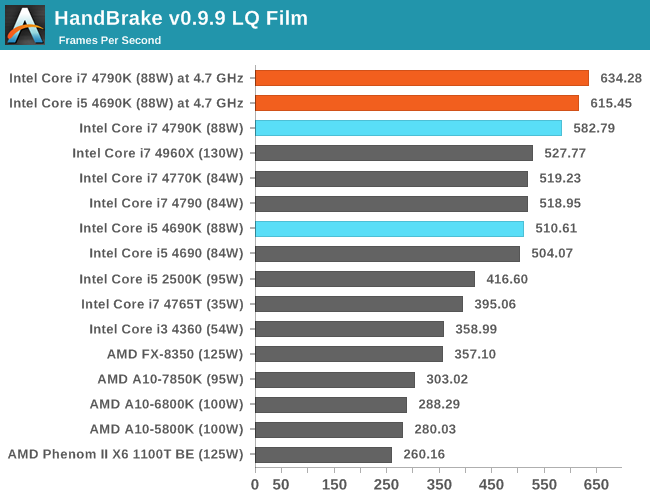
HandBrake, 4K60 Animation: link
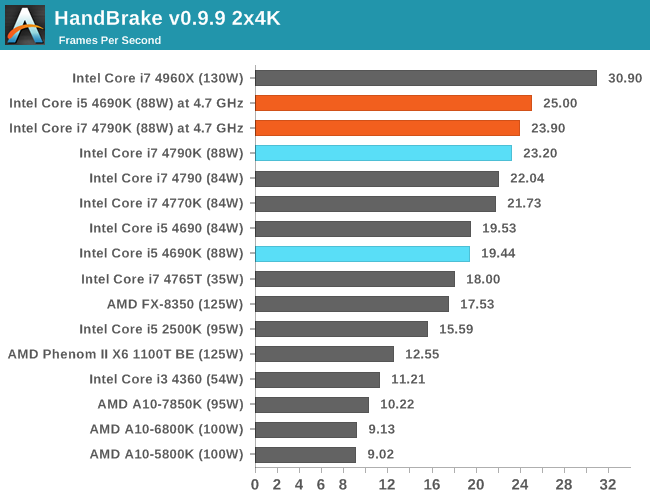
Agisoft Photoscan – 2D to 3D Image Manipulation: link
Agisoft Photoscan creates 3D models from 2D images, a process which is very computationally expensive. The algorithm is split into four distinct phases, and different phases of the model reconstruction require either fast memory, fast IPC, more cores, or even OpenCL compute devices to hand. Agisoft supplied us with a special version of the software to script the process, where we take 50 images of a stately home and convert it into a medium quality model. This benchmark typically takes around 15-20 minutes on a high end PC on the CPU alone, with GPUs reducing the time.
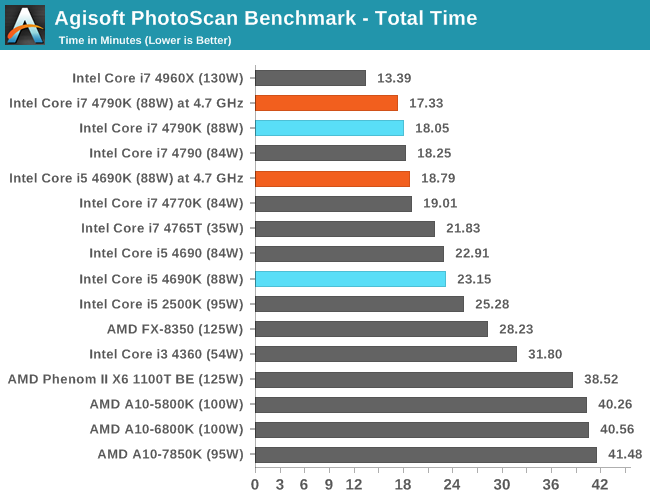
Dolphin Benchmark: link
Many emulators are often bound by single thread CPU performance, and general reports tended to suggest that Haswell provided a significant boost to emulator performance. This benchmark runs a Wii program that raytraces a complex 3D scene inside the Dolphin Wii emulator. Performance on this benchmark is a good proxy of the speed of Dolphin CPU emulation, which is an intensive single core task using most aspects of a CPU. Results are given in minutes, where the Wii itself scores 17.53 minutes.
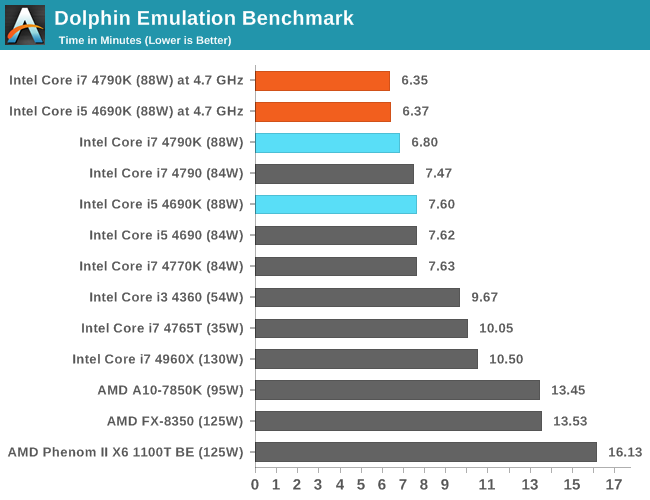
WinRAR 5.0.1: link
This test compresses a set of 2867 files across 320 folders totaling 1.52 GB in size – 95% of these files are small typical website files, and the rest (90% of the size) are small 30 second 720p videos.
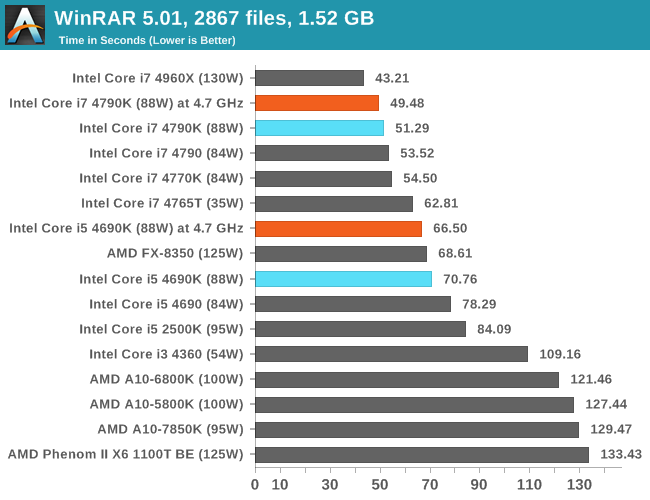
PCMark8 v2 Work 2.0 OpenCL on IGP
A new addition to our CPU testing suite is PCMark8 v2, where we test the Work 2.0 and Creative 3.0 suites in OpenCL mode. As this test is new, we have not run it on many AMD systems yet and will do so as soon as we can.
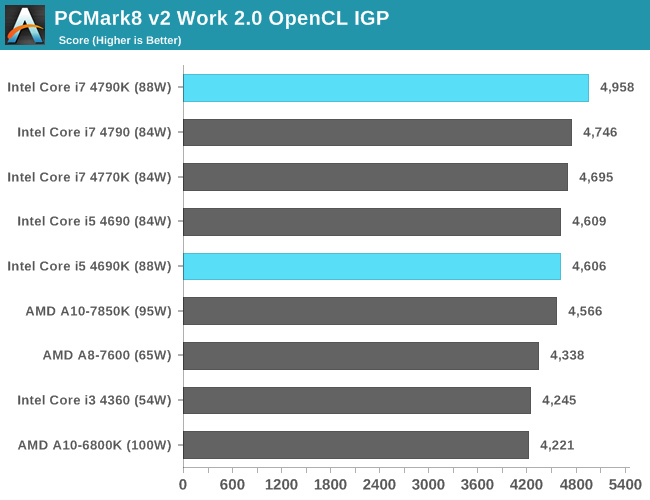
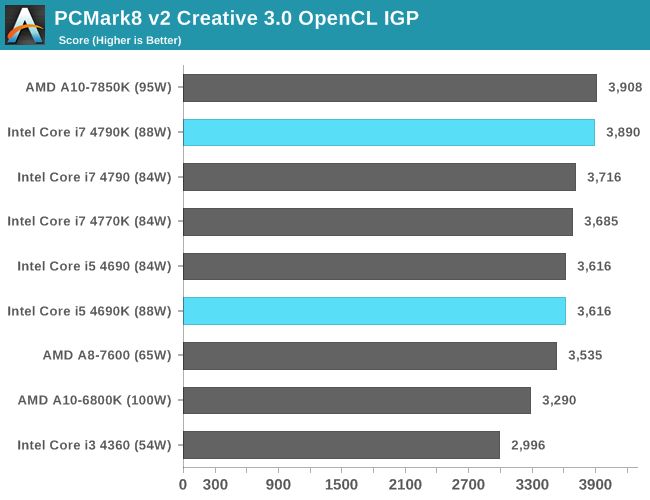
Hybrid x265
Hybrid is a new benchmark, where we take a 4K 1500 frame video and convert it into an x265 format without audio. Results are given in frames per second.
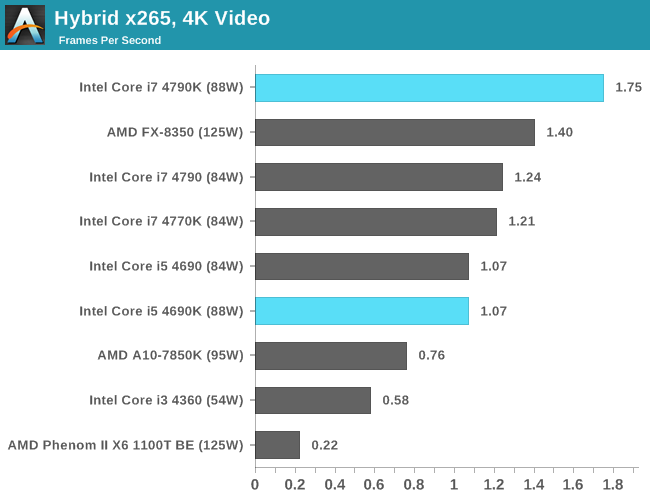
Cinebench R15


3D Particle Movement
3DPM is a self-penned benchmark, taking basic 3D movement algorithms used in Brownian Motion simulations and testing them for speed. High floating point performance, MHz and IPC wins in the single thread version, whereas the multithread version has to handle the threads and loves more cores.
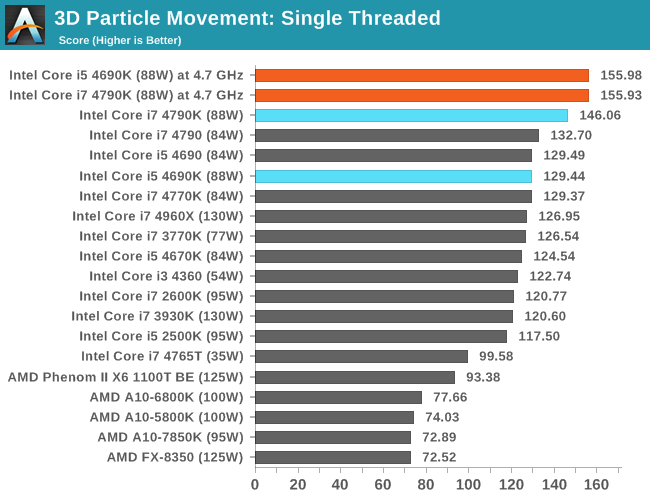
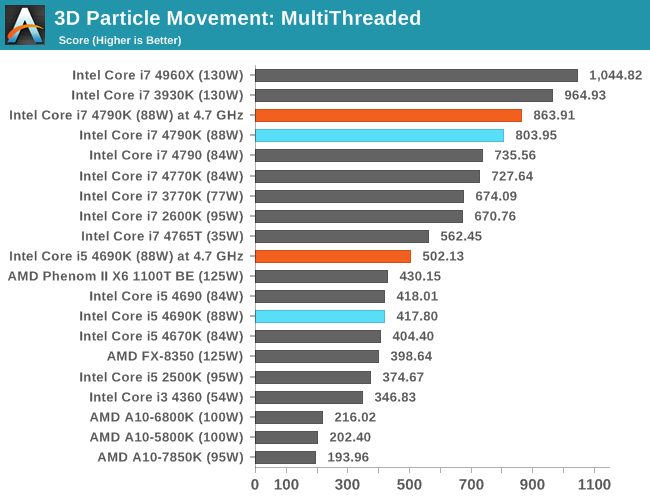
FastStone Image Viewer 4.9
FastStone is the program I use to perform quick or bulk actions on images, such as resizing, adjusting for color and cropping. In our test we take a series of 170 images in various sizes and formats and convert them all into 640x480 .gif files, maintaining the aspect ratio. FastStone does not use multithreading for this test, and results are given in seconds.
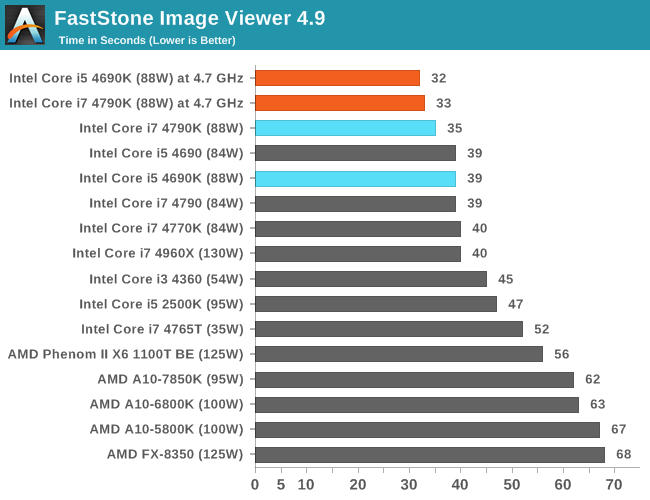
All of our CPU benchmarks are responsive to more frequency, and for tests that are all about single threaded performance (3DPM-ST, FastStone, Dolphin), the overclocked processors match each other. The highly clocked i7-4790K at stock is taking the lead in each of these benchmarks against the other processors at stock frequencies quite easily. For multi-threaded scenarios, it is interesting to note that when overclocked, Handbrake does not seem to use the extra threads that efficiently when encoding 4K60. This is presumably because each thread needs a fair amount of cache and there is little speed-up in switching the work between threads.
Gaming and Synthetics on Processor Graphics
Intel's GT2 (HD 4600) design dominates most of the Haswell CPU lineup from i3 and up. The differentiator between the i3, i5 and i7 CPUs tends to be the IGP multiplier, which affords 1150 MHz to 1250 MHz depending on the exact SKU. The AMD APUs run away with the top places in most of our IGP tests, and it is pretty clear that overclocking the CPU has little-to-no affect at these quality settings.
F1 2013
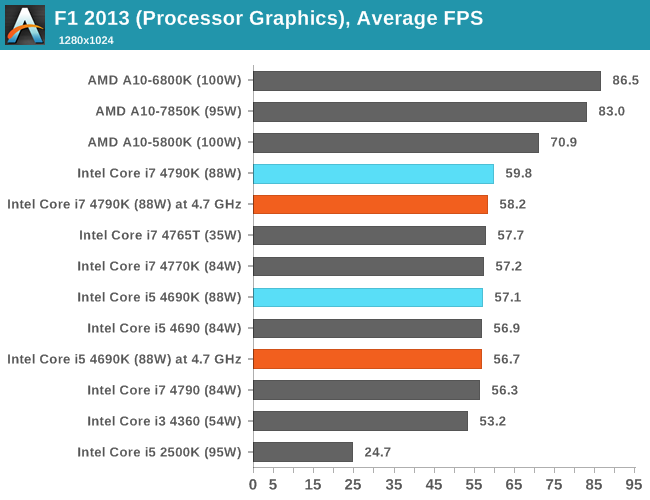
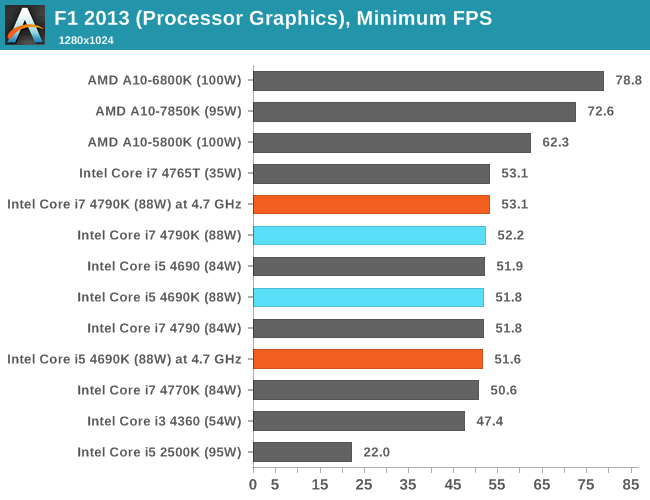
Bioshock Infinite
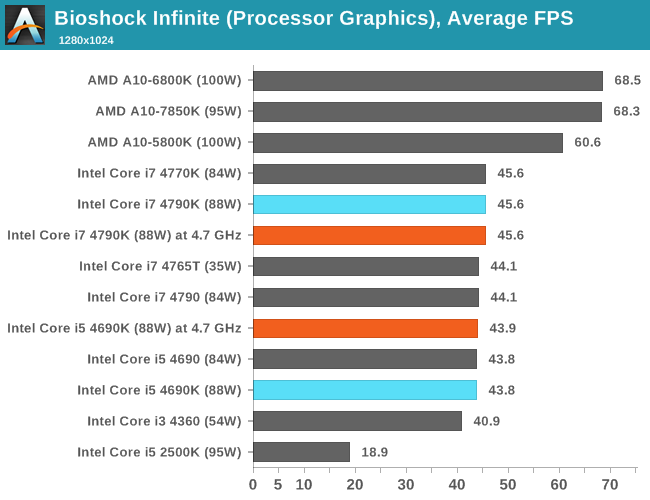
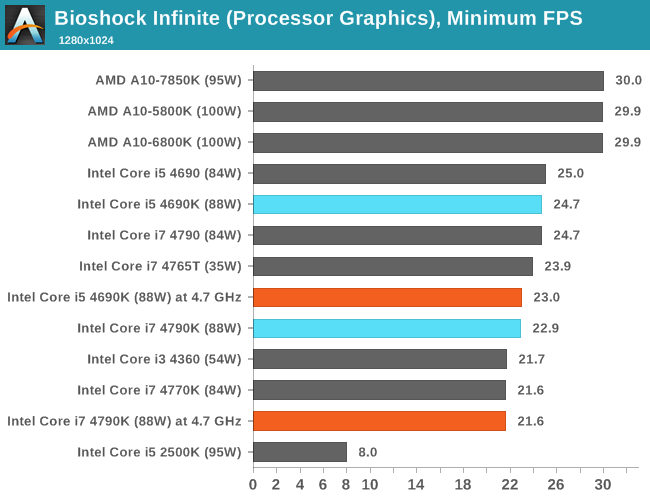
Tomb Raider
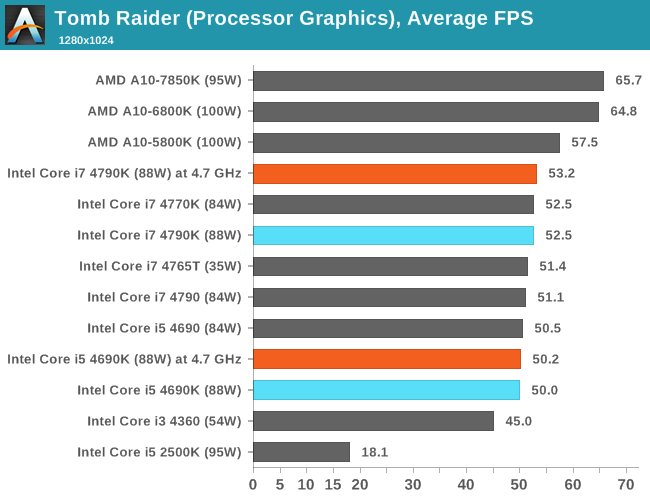
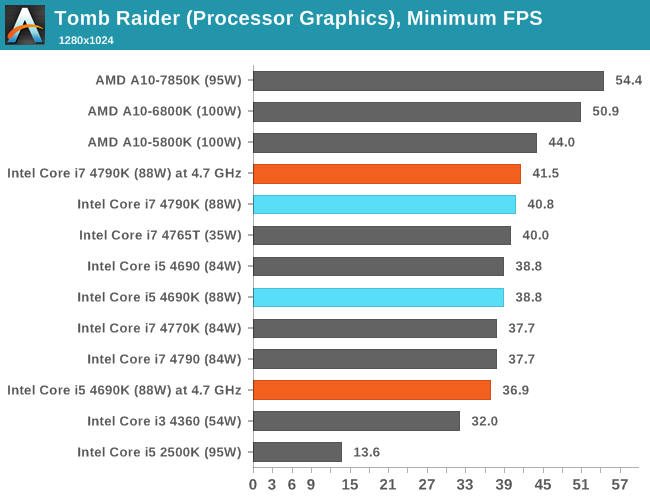
Sleeping Dogs

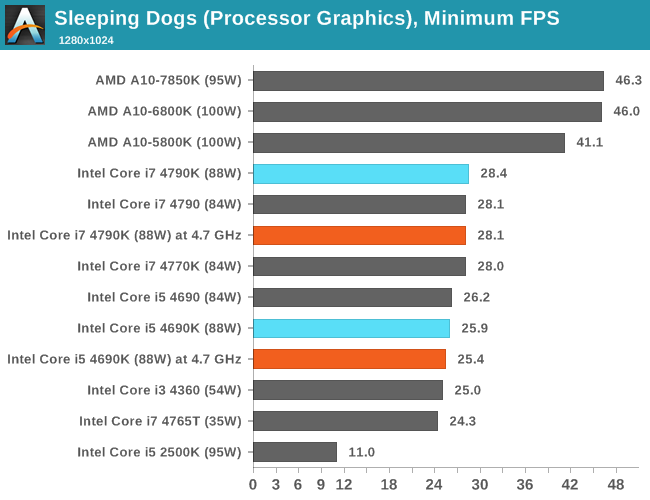
Company of Heroes 2
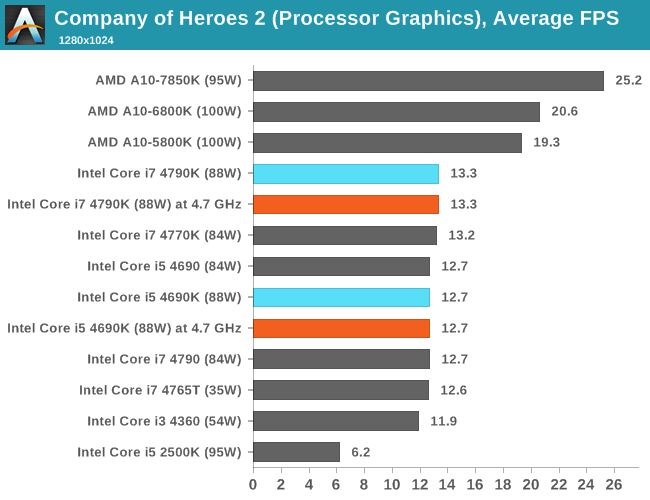
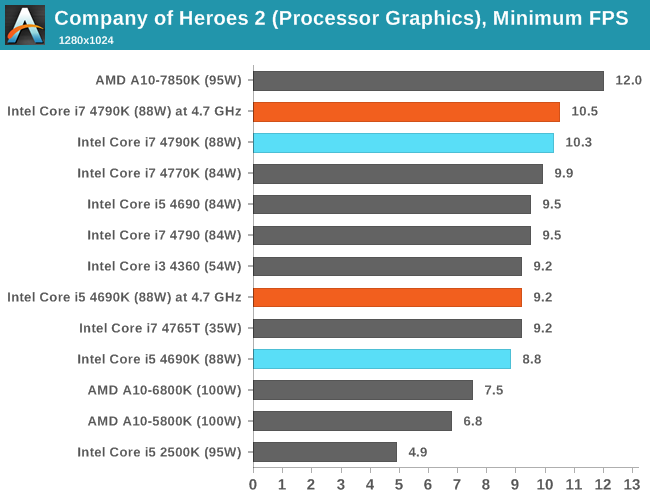
CompuBench 1.5
CompuBench is a new addition to our CPU benchmark suite, and as such we have only tested it on the following processors. The software uses OpenCL commands to process parallel information for a range of tests, and we use the flow management and particle simulation benchmarks here.
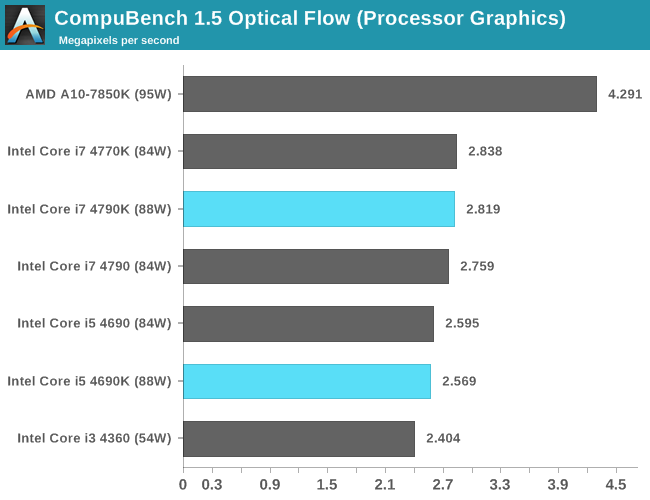
CompuBench 1.5 64k Particle Simulation
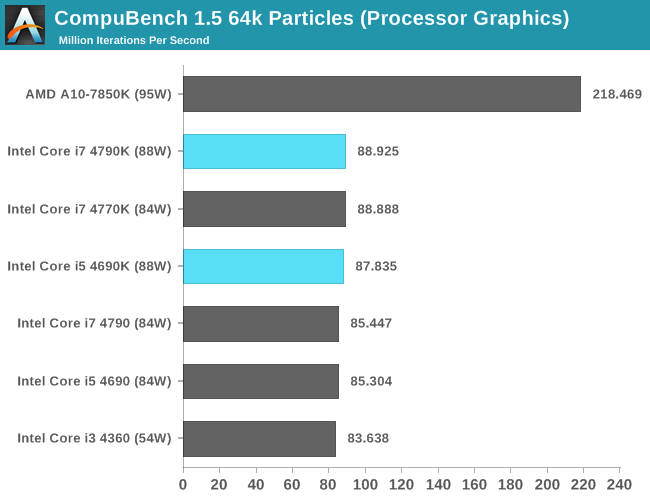
3DMark Fire Strike
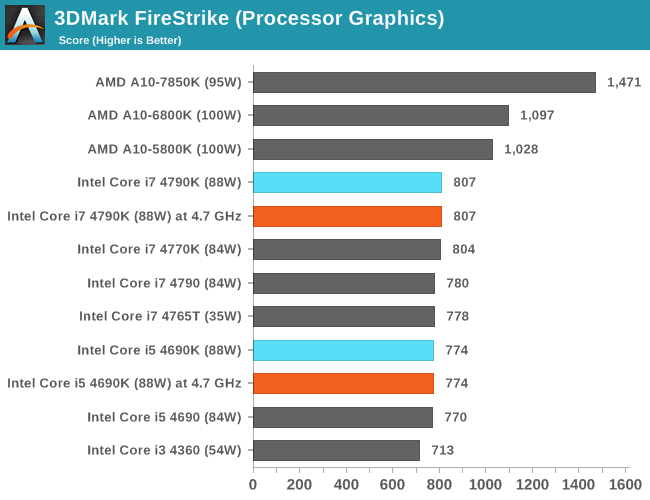
Discrete GPU Gaming
When comparing CPUs to APUs, one strength shown by team Blue in the past is the discrete GPU performance. However even when using dual graphics cards at a 1920x1080p resolution, we seem to have hit a wall where extra CPU performance does not necessarily translate to more frames per second. Our results below show little difference between the Haswell processors, and we need to go down to a 2.0 GHz i7 or a 3.5 GHz i3 CPU to see a significant drop in frame rates. The biggest benefit from overclocking seems to be F1 2013 minimum frame rates.
F1 2013
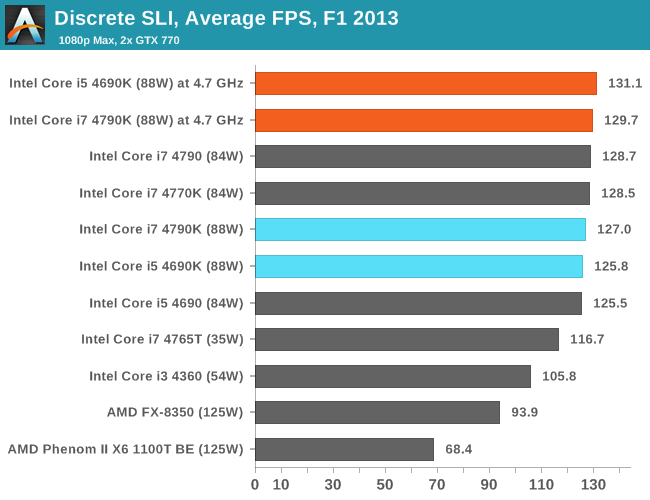

Bioshock Infinite
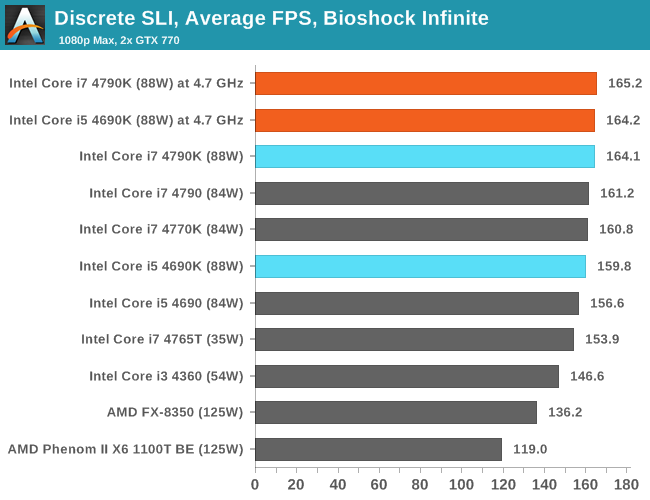
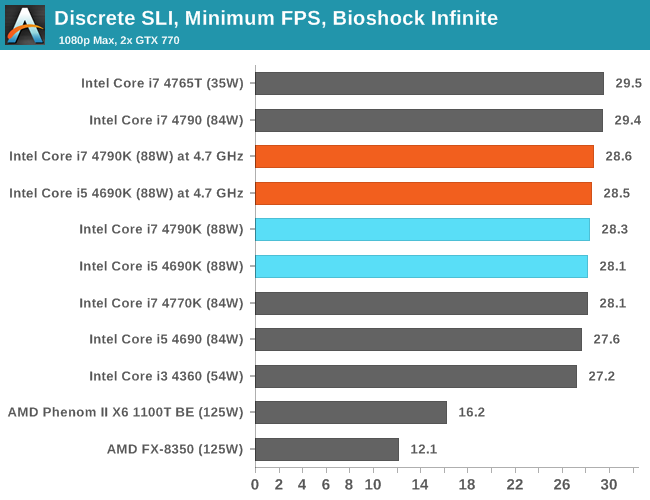
Tomb Raider
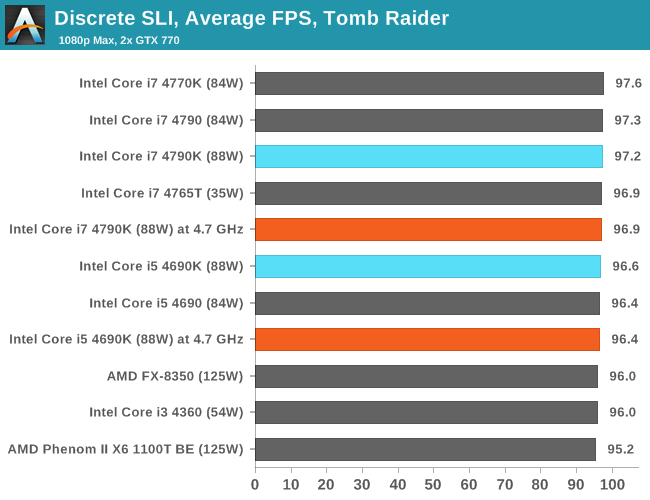
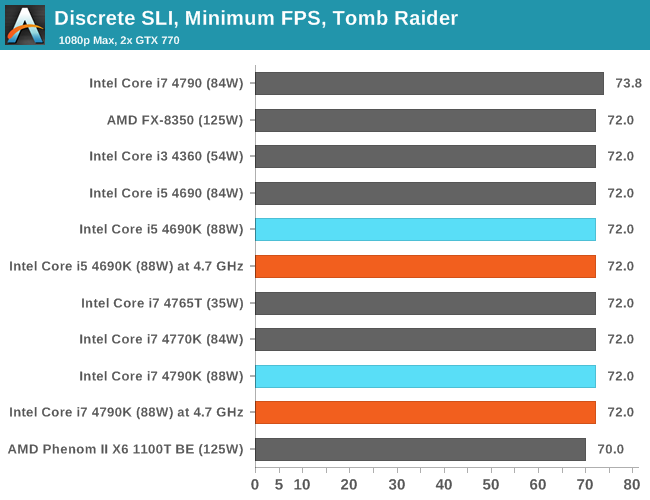
Sleeping Dogs
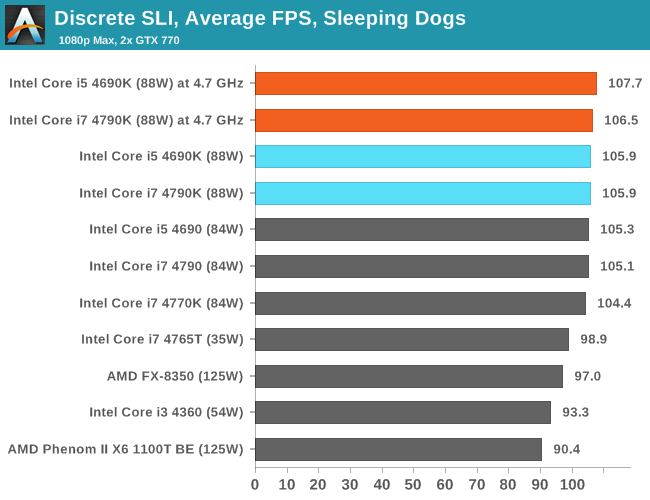
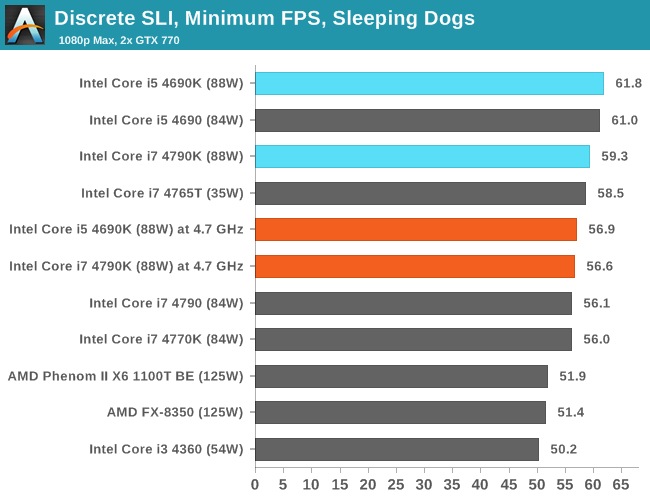
Company of Heroes 2
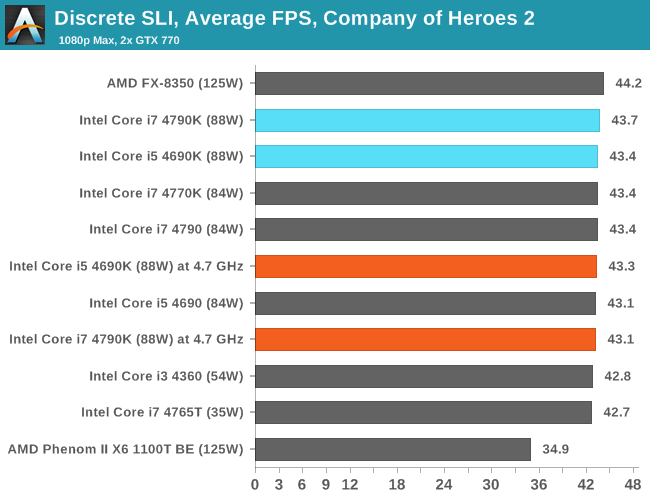

Battlefield 4

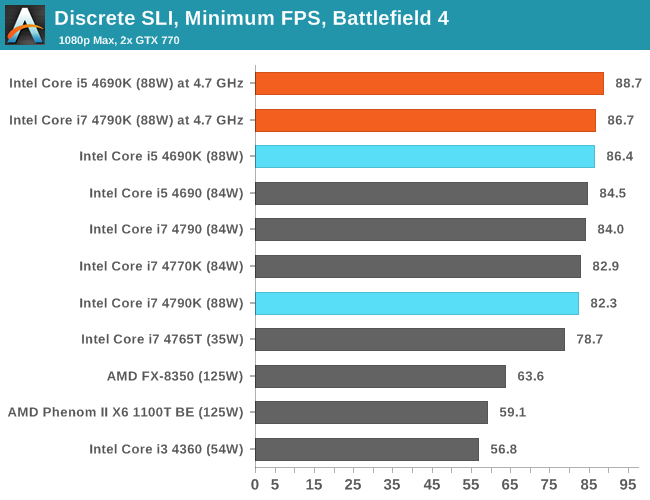
Conclusions
End-users with CPU intensive workloads always feel justified in requesting for more performance. The only question is if that performance is required at the expense of power, and if the CPU company feel satisfied they can offer a higher performance component with absolute stability. Over the past three generations, Intel CPUs at equal frequency have offered a 5-10% performance boost over the previous generation, usually around the same power envelope. Because 2014 would seem to be a year where there is no major generation change for the mainstream market segment, in order to provide that 10% boost, they have had to go directly at clock speeds.
With the clock speed change, the package is also adjusted in two distinct ways. The first is to add extra decoupling capacitors on the PCB, allowing the voltage regulator on the die to deliver cleaner power to where it needs to go. The second addresses the issue of temperature, whereby the heat generated by the processor is removed. By adjusting the thermal interface material, Intel hopes to have a CPU that is ~10C cooler than the original Haswell CPUs at the same frequency and voltage. This latter part is directly observable, and even when overclocked, the ~10C temperature difference is very much visible.
This leads on to overclocking, the supposed reason for the release of Devil’s Canyon. Lisa Graff, VP and GM of Intel’s Desktop Client Platform Group, indicated in a press call before Computex that the lead design teams on Devil’s Canyon had six months to make the changes, and that the CPUs were aimed at addressing concerns levied at Intel from users who enjoy overclocking. The main concerns were the variability of the headroom of the Haswell CPU line, where some CPUs could only manage +5% whereas others gave +20% extra frequency, along with high temperatures at low clock speeds. By releasing the i7-4790K at 4.0 GHz/4.4 GHz Turbo, this ensures that the out-of-the-box i7-4790K has a better performance than the lowest performing overclocked i7-4770K CPUs. The adjustment in the thermal interface material (which we suspect is a change in the ceramic filler to an aluminum oxide or derivative therein) also gives more headroom for the i7-4790K CPUs that might have been temperature limited otherwise.
For our overclocking performance, both of our CPUs were hitting their voltage limitations as a result of the temperature adjustment. At the top end of our final overclocks, in order to adjust +100 MHz to be fully stable required a large jump of +0.100 volts, pushing the CPU voltage outside of the recommended window for a 24/7 stable Haswell-based processor. Both the i7-4790K and the i5-4690K in our testing gave 4.7 GHz benchmark stable, 100 MHz more than our first i7-4770K sample and 500 MHz more than our second i7-4770K sample.
This ends up being the main selling point for the overclocking end-user: if you own a relatively mediocre Sandy Bridge, Ivy Bridge or Haswell CPU, and have CPU limited throughput, there can be performance gains by investing into the Devil’s Canyon (CPU + Z97 motherboard or Z87 with BIOS updates) ecosystem. These are ‘enhancements’ that Intel should build on for the future, and never remove. I am sure that many enthusiasts would like to see a return to soldering the IHS on, or a single version with this feature.
For users relying on an Ivy Bridge stock system, the i7 Devil’s Canyon can offer a 17% increase over the i7-3770K for CPU benchmarks. For those that need the fastest single-thread VT-d enabled processor according to Intel's specification pages, the i7-4790K also affords that opportunity.
Users that are looking for the fastest GPU for gaming, at 1080p, might not be impressed by either the i5 or i7 Devil’s Canyon. At least in our testing, we saw no improvement from Ivy Bridge to Devil’s Canyon. One might argue that the story would be different for online gaming, or at larger resolutions, however for the latter there is more emphasis on upgrading the GPU over the CPU. While some hardware setups offer this mainstream CPU with three and four-way GPU gaming, typically we end up recommending the extreme platform due to fewer PCIe switches required.
The next question is oriented towards the future. Will the next generation of Intel CPUs perform better than Devil’s Canyon? The expected release date of Broadwell CPUs is still unknown, as is the extent of Intel's desktop offerings. Some media are expecting Broadwell to be more IGP focused as a platform, given the initial expectations of no desktop parts. To put this into perspective: if Broadwell offers a 5-10% IPC increase, Intel has to offer a 4.0 GHz / 4.4 GHz Turbo version in order to make their fastest mainstream processor even faster. However, given the history of Intel’s releases, if they release a top end i7, it will most likely be a 3.6 GHz / 4.0 GHz Turbo part, and offer the same performance as Devil’s Canyon. We cannot predict the overclocking potential, or if Intel is going to migrate the ‘enhanced overclocking features’ of Devil’s Canyon to the new parts. If this is the case, Intel will have to offer a new 'feature' to help sell the new high end parts.
The user has to hedge their bets – when is Broadwell coming to market, and is there going to be a large OC version of Broadwell, the equivalent of Devil’s Canyon is to Haswell? We are currently looking at 5 months away from Broadwell-Y (also known as Core-M) based on Intel announcements but no indication yet when Broadwell-DT is released, meaning an investment in Devil’s Canyon gives the top class mainstream processor based system until then.
The next piece of the puzzle is Haswell-E where many sources, such as CPU-World, are quoting that the low end SKU (an i7-5820K going by previous naming schemes) will be a six-core 3.3 GHz CPU with some amount of turbo. Historically Intel has charged roughly the same amount for the lowest Enthusiast CPU and the top Mainstream CPU, although this time the lowest Enthusiast CPU will have two more cores. So until Haswell-E is released, along with DDR4 and the X99 chipset, Devil’s Canyon might sit in the ‘should I wait’ category. But if we were looking at upgrading that main system today, based on CPU limited workloads, the i7-4790K is a well recommended choice.

